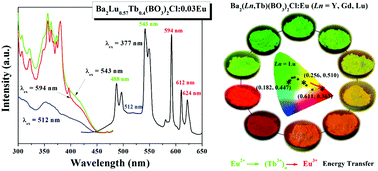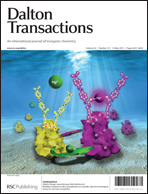A new strategy based on the host composition design has been adopted to obtain efficient color-tunable emission from Ba2Ln0.97−zTbz(BO3)2Cl:0.03Eu (Ln = Y, Gd and Lu, z = 0–0.97) phosphors. This study reveals that the single-phase Ba2Ln1−zTbz(BO3)2Cl compounds can be applied to use allowed Eu2+ absorption transitions to sensitize Eu3+ emission via the energy transfer Eu2+ → (Tb3+)n → Eu3+. The powder X-ray diffraction (XRD) and Rietveld refinement analysis shows single-phase Ba2Ln1−zTbz(BO3)2Cl. As-prepared Ba2Ln0.97−zTbz(BO3)2Cl:0.03Eu phosphors show intense green, yellow, orange and red emission under 377 nm near ultraviolet (n-UV) excitation due to a variation in the relative intensities of the Eu2+, Tb3+ and Eu3+ emission depending on the Tb content (z) in the host composition, allowing color tuning. The variation in emission color is explained by energy transfer and has been investigated by photoluminescence and lifetime measurements and is further characterized by the Commission Internationale de l’éclairage (CIE) chromaticity indexes. The quantum efficiencies of the phosphors are high, up to 74%, and show good thermal stabilities up to 150 °C. This investigation demonstrates the possibility to sensitize Eu3+ line emission by Eu2+via energy migration over Tb3+ resulting in efficient color tunable phosphors which are promising for use in solid-state white light-emitting diodes (w-LEDs).

You have access to this article
 Please wait while we load your content...
Something went wrong. Try again?
Please wait while we load your content...
Something went wrong. Try again?


 Please wait while we load your content...
Please wait while we load your content...